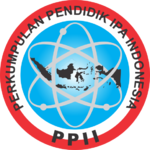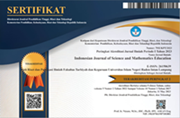Design thinking in science education during the last six years: A bibliometric analysis
Abstract
Keywords
Full Text:
PDFReferences
A. Abulibdeh, E. Zaidan, and R. Abulibdeh, “Navigating the confluence of artificial intelligence and education for sustainable development in the era of industry 4.0: Challenges, opportunities, and ethical dimensions,” J. Clean. Prod., vol. 437, no. 1, pp. 1-8, 2024, doi: 10.1016/j.jclepro.2023.140527
Z. Deng, “Powerful Knowledge, Educational potential and knowledge-rich curriculum: Pushing the boundaries,” J. Curric. Stud., vol. 54, no. 5, pp. 599–617, 2022, doi : 10.1080/00220272.2022.2089538
F. X. L. L. Flower and J. T. Sugirtha, “Education 4.0: Revisiting contemporary paradigms in social work education,” in Industry 4.0 Technologies for Education, Auerbach Publications, 2022, ch.10, pp. 359–368, doi: 10.1201/9781003318378-22
K. Rawboon, A. K. Yamazaki, W. Klomklieng, and W. Thanomsub, “Future competencies for three demanding careers of industry 4.0: Robotics engineers, data scientists, and food designers,” J. Competency‐Based Educ., vol. 6, no. 2, pp. 1-12, 2021, doi: 10.1002/cbe2.1253
N. Rosenberg, “Technological change in the machine tool industry, 1840–1910,” J. Econ. Hist., vol. 23, no. 4, pp. 414–443, 1963, doi: 10.1017/S0022050700109155
A. Buhl et al., “Design thinking for sustainability: Why and how design thinking can foster sustainability-oriented innovation development,” J. Clean. Prod., vol. 231, no. 1, pp. 1248–1257, 2019, doi; 10.1016/j.jclepro.2019.05.259
P. Micheli, S. J. S. Wilner, S. H. Bhatti, M. Mura, and M. B. Beverland, “Doing design thinking: Conceptual review, synthesis, and research agenda,” J. Prod. Innov. Manag., vol. 36, no. 2, pp. 124–148, 2019, doi: 10.1111/jpim.12466
H. J. Kim, P. Yi, and B. W. Ko, “Deepening students’ experiences with problem identification and definition in an empathetic approach: Lessons from a university design-thinking program,” J. Appl. Res. High. Educ., vol. 15, no. 3, pp. 852–865, 2023, doi: 10.1108/JARHE-03-2022-0083
W.-L. Yeung and O.-L. Ng, “Using empathy maps to support design-thinking enhanced transdisciplinary STEM innovation in K-12 setting,” Int. J. Technol. Des. Educ., vol. 34, no. 1, pp. 1–26, 2023, doi: 10.1007/s10798-023-09861-7
N. Donthu, S. Kumar, D. Mukherjee, N. Pandey, and W. M. Lim, “How to conduct a bibliometric analysis: An overview and guidelines,” J. Bus. Res., vol. 133, no. 1, pp. 285–296, 2021, doi: 10.1016/j.jbusres.2021.04.070
A. H. ALSHARIF, N. Salleh, and R. BAHARUN, “Bibliometric analysis,” J. Theor. Appl. Inf. Technol., vol. 98, no. 15, pp. 2948–2962, 2020.
Y. Y. Chun, “Bibliometric analysis of journal articles published by southeast asian chemical engineering researchers,” Malaysian J. Libr. Inf. Sci., vol. 14, no. 3, pp. 1–13, 2009.
P. Grandjean, M. L. Eriksen, O. Ellegaard, and J. A. Wallin, “The matthew effect in environmental science publication: A bibliometric analysis of chemical substances in journal articles,” Environ. Heal., vol. 10, no. 1, pp. 1–8, 2011, doi: 10.1186/1476-069X-10-96
C. A. Bonilla, J. M. Merigó, and C. Torres-Abad, “Economics in Latin America: A bibliometric analysis,” Scientometrics, vol. 105, no. 1, pp. 1239–1252, 2015, doi : 10.1007/s11192-015-1747-7
D. F. Al Husaeni, A. B. D. Nandiyanto, and R. Maryanti, “Bibliometric analysis of educational research in 2017 to 2021 using Vosviewer: Google Scholar indexed research,” Indones. J. Teach. Sci., vol. 3, no. 1, pp. 1–8, 2023, doi: 10.17509/ijotis.v3i1.43182
D. N. Al Husaeni, A. B. D. Nandiyanto, and R. Maryanti, “Bibliometric analysis of special needs education keyword using vosviewer indexed by Google Scholar,” Indones. J. Community Spec. Needs Educ., vol. 3, no. 1, pp. 1–10, 2023, doi: 10.17509/ijcsne.v3i1.43181
R. Ragadhita and A. B. D. Nandiyanto, “Computational bibliometric analysis on publication of techno-economic education,” Indones. J. Multidiciplinary Res., vol. 2, no. 1, pp. 213–222, 2022, doi: 10.17509/ijomr.v2i1.43180
A. Bhandari, "Design thinking: From bibliometric analysis to content analysis, current research trends, and future research directions," Journal of the Knowledge Economy, vol. 14, no. 3. pp. 3097-3152, 2023. doi: 10.1007/s13132-022-00920-3, doi: 10.1007/s13132-022-00920-3
N. M. Aris et al., “Evaluating the academic trends on design thinking research: A bibliometric analysis from 2000 to 2021,” J. Posit. Sch. Psychol., vol. 6, no. 4, pp. 1022–1038, 2022.
N. Dragičević, G. Vladova, and A. Ullrich, “Design thinking capabilities in the digital world: A bibliometric analysis of emerging trends,” Front. Educ., vol. 7, no. 1, pp. 1–18, 2023, doi: 10.3389/feduc.2022.1012478
R. Razzouk and V. Shute, “What is design thinking and why is it important?,” Rev. Educ. Res., vol. 82, no. 3, pp. 330–348, 2012, doi : 10.3102/0034654312457429
D. Pusca and D. O. Northwood, “Design thinking and its application to problem solving,” Glob. J. Eng. Educ., vol. 20, no. 1, pp. 48–53, 2018.
E. E. Inglesis Barcellos and G. Botura, “Design thinking: User-centered multidisciplinary methodology based on people and innovation,” in Advances in Human Factors, Business Management and Leadership: Proceedings of the AHFE 2017 International Conferences on Human Factors in Management and Leadership, and Business Management and Society, July 17− 21, 2017, The Westin Bonaventure Hotel, Los , 2018, pp. 173–182, doi: 10.1007/978-3-319-60372-8_17
N. Suprapto, A. Kholiq, B. K. Prahani, and U. A. Deta, “Research on physics of photography: A bibliometric study (2000-2020),” in Journal of Physics: Conference Series, vol. 2110, no. 1, 2021, pp. 1-8, doi: 10.1088/1742-6596/2110/1/012017
K. S. Taber, “The use of Cronbach’s Alpha when developing and reporting research instruments in science education,” Res. Sci. Educ., vol. 48, no. 1, pp. 1273–1296, 2018, doi: 10.1007/s11165-016-9602-2
N. Cross, Design thinking: Understanding how designers think and work. New York: Bloomsbury Publishing, 2023, doi: 10.5040/9781350305090
G. DeBoer, A history of ideas in science education. New York: Teachers college press, 2019.
M. Stickdorn, M. E. Hormess, A. Lawrence, and J. Schneider, This is service design doing: Applying service design thinking in the real world. Sebastopol : O'Reilly media, 2018.
V. Braun and V. Clarke, “Conceptual and design thinking for thematic analysis,” Qual. Psychol., vol. 9, no. 1, pp. 3-26, 2022, doi : 10.1037/qup0000196
K. D. Elsbach and I. Stigliani, “Design thinking and organizational culture: A review and framework for future research,” J. Manage., vol. 44, no. 6, pp. 2274–2306, 2018, doi: 10.1177/0149206317744252
J. Liedtka, “Why design thinking works,” Harv. Bus. Rev., vol. 96, no. 5, pp. 72–79, 2018.
T. Martín‐Páez, D. Aguilera, F. J. Perales‐Palacios, and J. M. Vílchez‐González, “What are we talking about when we talk about STEM education? A Review of Literature,” Sci. Educ., vol. 103, no. 4, pp. 799–822, 2019, doi: 10.1002/sce.21522
S. Bal-Taştan, S. M. M. Davoudi, A. R. Masalimova, A. S. Bersanov, R. A. Kurbanov, A. V. Boiarchuk, A. A. Pavlushin, “The impacts of teacher’s efficacy and motivation on student’s academic achievement in science education among secondary and high school students,” EURASIA J. Math. Sci. Technol. Educ., vol. 14, no. 6, pp. 2353–2366, 2018, doi : 10.29333/ejmste/97832
M. Lewrick, P. Link, and L. Leifer, The design thinking playbook: Mindful digital transformation of teams, products, services, businesses and ecosystems. Spanyol: Scrum Manager, 2018.
M. Altman, T. T. K. Huang, and J. Y. Breland, “Peer reviewed: Design thinking in health care,” Prev. Chronic Dis., vol. 15, no. 117, pp. 1-13, 2018, doi: 10.5888/pcd15.180128
M. Chowdhury, “Emphasizing morals, values, ethics, and character education in science education and science teaching,” MOJES Malaysian Online J. Educ. Sci., vol. 4, no. 2, pp. 1–16, 2018.
J. Gess-Newsome, J. A. Taylor, J. Carlson, A. L. Gardner, C. D. Wilson, and M. A. M. Stuhlsatz, “Teacher pedagogical content knowledge, practice, and student achievement,” Int. J. Sci. Educ., vol. 41, no. 7, pp. 944–963, 2019, doi: 10.1080/09500693.2016.1265158
L. Claus, “HR disruption time already to reinvent talent management,” BRQ Bus. Res. Q., vol. 22, no. 3, pp. 207–215, 2019, doi: 10.1016/j.brq.2019.04.002
J. Carlson et al., “The refined consensus model of pedagogical content knowledge in science education,” Repositioning Pedagog. content Knowl. Teach. Knowl. Teach. Sci., vol. 1, no. 1, pp. 77–94, 2019.
S. Grover and R. Pea, “Computational thinking: A competency whose time has come,” Comput. Sci. Educ. Perspect. Teach. Learn. Sch., vol. 19, no. 1, pp. 19–38, 2018, doi : 10.5040/9781350057142.ch-003
T. Brown, “Change by design. revised and updated,” How Des. Think. Transform. Organ. California: Inspires Innov. Harperbus., 2019.
Siti Zubaidah, “Mengenal 4C: learning and innovation skills untuk menghadapi era revolusi industri 4.0,” 2nd Sci. Educ. Natl. Conf., no. September, vol. 12, no. 2, pp. 1–18, 2018.
M. Kalogiannakis, S. Papadakis, and A.-I. Zourmpakis, “Gamification in science education: A systematic review of the literature,” Educ. Sci., vol. 11, no. 1, pp. 1-36, 2021, doi: 10.3390/educsci11010022
L. Judijanto, Y. Yuanti, and S. Supriandi, “Population health management: A bibliometric analysis of literature on data analytics and public health interventions,” West Sci. Interdiscip. Stud., vol. 2, no. 4, pp. 778–788, 2024, doi: 10.58812/wsis.v2i04.796
DOI: http://dx.doi.org/10.24042/ijsme.v7i3.23067
Refbacks
- There are currently no refbacks.
Copyright (c) 2024 Unit Riset dan Publikasi Ilmiah FTK UIN Raden Intan Lampung

This work is licensed under a Creative Commons Attribution-ShareAlike 4.0 International License.

Indonesian Journal of Science and Mathematics Education is licensed under a Creative Commons Attribution-ShareAlike 4.0 International License.



